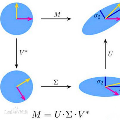Graph Representation Learning (GRL) is an upcoming and promising area in recommendation systems. In this paper, we revisit the Singular Value Decomposition (SVD) of adjacency matrix for embedding generation of users and items and use a two-layer neural network on top of these embeddings to learn relevance between user-item pairs. Inspired by the success of higher-order learning in GRL, we further propose an extension of this method to include two-hop neighbors for SVD through the second order of the adjacency matrix and demonstrate improved performance compared with the simple SVD method which only uses one-hop neighbors. Empirical validation on three publicly available datasets of recommendation system demonstrates that the proposed methods, despite being simple, beat many state-of-the-art methods and for two of three datasets beats all of them up to a margin of 10%. Through our research, we want to shed light on the effectiveness of matrix factorization approaches, specifically SVD, in the deep learning era and show that these methods still contribute as important baselines in recommendation systems.
翻译:图表教学(GRL)是建议系统中一个即将出现和有希望的领域。 在本文中,我们重新审视了用于嵌入用户和项目生成的相邻矩阵的单值分解(SVD),并用两层神经网络在这些嵌入器之上学习用户-项目对配对的相关性。由于在GRL中高级学习的成功,我们进一步提议扩大这一方法的范围,通过相邻矩阵的第二顺序将SVD的两层邻居包括在内,并展示了与仅使用一跳邻居的简单 SVD 方法相比的改进性能。对三种公开提供的建议系统数据集的实证验证表明,拟议方法尽管简单,许多最先进的方法和三个数据集中的两个将所有方法打到10%的边缘。通过我们的研究,我们要阐明在深层学习时代矩阵要素化方法的有效性,特别是SVD,并表明这些方法仍然作为建议系统的重要基线。




